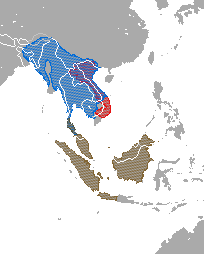
Back لوريس بطيء Arabic لوريس بطيء ARZ Boonsyatol (Nycticebus) AVK Tukang BAN Nycticebus Catalan Nycticebus CEB Plumploris German Nycticebus Spanish Nycticebus Basque چشمگرد تنبل Persian
| Slow lorises | |
|---|---|

| |
| Sunda slow lorisNycticebus coucang | |
| Scientific classification | |
| Domain: | Eukaryota |
| Kingdom: | Animalia |
| Phylum: | Chordata |
| Class: | Mammalia |
| Order: | Primates |
| Suborder: | Strepsirrhini |
| Family: | Lorisidae |
| Subfamily: | Lorinae |
| Genus: | Nycticebus É. Geoffroy, 1812[1] |
| Type species | |
| Tardigradus coucang[2] Boddaert, 1785
| |
| Species | |
| |

| |
| Distribution of Nycticebus and Xanthonycticebusred = X. pygmaeus;blue = N. bengalensis;brown = N. bancanus, N. borneanus, N. coucang, N. javanicus, N. kayan & N. menagensis | |
| Synonyms[4][5] | |
| |
Slow lorises are a group of several species of nocturnal strepsirrhine primates that make up the genus Nycticebus. Found in Southeast Asia and nearby areas, they range from Bangladesh and Northeast India in the west to the Sulu Archipelago in the Philippines in the east, and from Yunnan province in China in the north to the island of Java in the south.
Although many previous classifications recognized as few as a single all-inclusive species, there are now at least eight that are considered valid: the Sunda slow loris (N. coucang), Bengal slow loris (N. bengalensis), Javan slow loris (N. javanicus), Philippine slow loris (N. menagensis), Bangka slow loris (N. bancanus), Bornean slow loris (N. borneanus), Kayan River slow loris (N. kayan) and Sumatran slow loris (N. hilleri). A ninth species, the pygmy slow loris (X. pygmaeus), was recently moved to the new genus Xanthonycticebus.[6] After the pygmy slow loris, the group's closest relatives are the slender lorises of southern India and Sri Lanka. Their next closest relatives are the African lorisids, the pottos, false pottos, and angwantibos. They are less closely related to the remaining lorisoids (the various types of galago), and more distantly to the lemurs of Madagascar. Their evolutionary history is uncertain since their fossil record is patchy and molecular clock studies have given inconsistent results.
Slow lorises have a round head, a narrow snout, large eyes, and a variety of distinctive coloration patterns that are species-dependent. Their arms and legs are nearly equal in length, and their torso is long and flexible, allowing them to twist and extend to nearby branches. The hands and feet of slow lorises have several adaptations that give them a pincer-like grip and enable them to grasp branches for long periods of time. Slow lorises have a toxic bite, a trait rare among mammals and unique among the primates.[7] The toxin is obtained by licking a sweat gland on their arm, and the secretion is activated by mixing with saliva. Their toxic bite, once thought to be primarily a deterrent to predators, has been discovered to be primarily used in disputes within the species.
The secretion from the arm contains a chemical related to cat allergen, but may be augmented by secondary toxins from the diet in wild individuals. Slow lorises move slowly and deliberately, making little or no noise, and when threatened, they stop moving and remain motionless. Their only documented predators—apart from humans—include snakes, changeable hawk-eagles and orangutans, although cats, viverrids and sun bears are suspected. Little is known about their social structure, but they are known to communicate by scent marking. Males are highly territorial. Slow lorises reproduce slowly, and the infants are initially parked on branches or carried by either parent. They are omnivores, eating small animals, fruit, tree gum, and other vegetation.
Each of the slow loris species that had been identified prior to 2012 is listed as either "Vulnerable" or "Endangered" on the IUCN Red List. The three newest species are yet to be evaluated, but they arise from (and further reduce the ranks of) what was thought to be a single "vulnerable" species. All four of these are expected to be listed with at least the same, if not a higher-risk, conservation status. All slow lorises are threatened by the wildlife trade and habitat loss. Their habitat is rapidly disappearing and becoming fragmented, making it nearly impossible for slow lorises to disperse between forest fragments; unsustainable demand from the exotic pet trade and from traditional medicine has been the greatest cause for their decline.
- ^ Groves 2005, pp. 122–123.
- ^ Wilson, D. E.; Reeder, D. M., eds. (2005). Mammal Species of the World: A Taxonomic and Geographic Reference (3rd ed.). Johns Hopkins University Press. ISBN 978-0-8018-8221-0. OCLC 62265494.
- ^ Cite error: The named reference
CITES_Appswas invoked but never defined (see the help page). - ^ "Table 2 b: taxonomic names and synonyms used by several authors: genus, species, subspecies, populations" (PDF). Loris and potto conservation database. www.loris-conservation.org. 4 February 2003. p. 3. Archived (PDF) from the original on 18 April 2016. Retrieved 30 April 2013.
- ^ "Synonyms of Slow Lorises (Nycticebus)". Encyclopedia of Life. eol.org. Archived from the original on 5 December 2013. Retrieved 30 April 2013.
- ^ Cite error: The named reference
Xanthwas invoked but never defined (see the help page). - ^ Basic Biology (2015). "Primates". Archived from the original on 13 January 2020. Retrieved 6 March 2020.